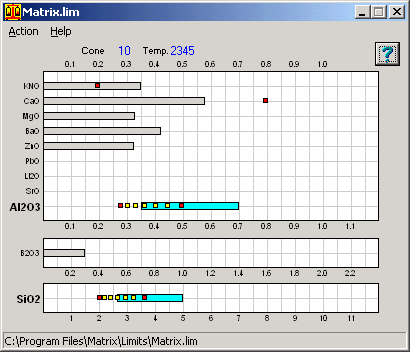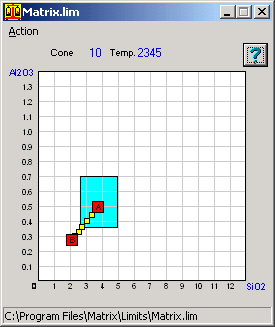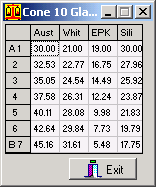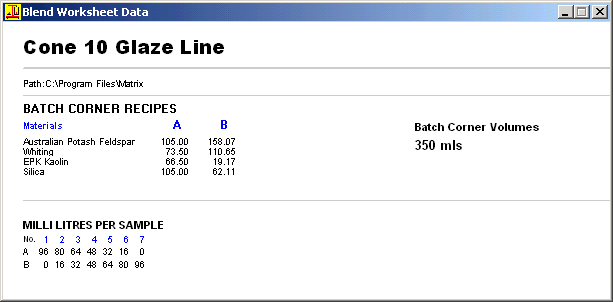|
When you have
completed the creation of a blend you may view the data which has
been generated by Matrix by clicking buttons in the Display Blend
Data panel. The information available includes:
- worksheet
data which is used to physically mix the blend.
- individual
recipes generated for the blend
- the unity
formula for each of the recipes in the blend
- the blend
formulae displayed on either an enlarged Limits Graph or an enlarged
Al:Si Graph
Fig.1 shows
the Blends environment display after the completion of a blend creation
process - this line blend was create in Making
a Line Blend
Accessing
Blend Data on Screen

Fig.1
The Line Blend has been created. Data can be viewed and printed. |
After
the blend has been created. (Fig.1)
Click
the OK button to close
the Checking Blends Progress window.
The Display
Blend Data panel offers buttons which will open
windows containing blend information.
The  button will open an enlarged Limits Graph (Fig.2) with the
formulae for all of the individual blend recipes displayed.
button will open an enlarged Limits Graph (Fig.2) with the
formulae for all of the individual blend recipes displayed.
This is
useful to check that you have achieved the desired range of
formula values across the blend.
|
Viewing
the Blends Limits Graph

Fig.2
The Blends Limits Graph showing the Cone 10 Line Blend |
The Blends
Limits Graph (Fig.2) displays the limits for the temperature
set in the Recipe to Formula environment.
The dots
on the graph represent the formula values for each of the
oxides across all of the recipes generated in the blend.
The red
dots represent values in the corner recipes of the blend.
In Cone
10 Glaze Blend line blend the flux oxide values were kept
constant and we created new Al2O3 and SiO2 values in recipe
B. The recipes in the blend therefore show a range of Al2O3
and SiO2 values across the blend while the KNO and CaO values
are kept constant.
|
Viewing the Blends AlSi Graph
|

Fig.3
The Blends Al:Si Graph
|
The  button
will open an enlarged Al:Si Graph button
will open an enlarged Al:Si Graph
The Blends
Al:Si Graph displays the Al2O3 and SiO2 limits for the temperature
set in the Recipe to Formula environment.
The formula
values of Al2O3 and SiO2 in each of the line blend recipes
is shown on the graph.
The red
squares indicate the formula values for the corner recipes.
Again
the distribution of Al2O3 and SiO2 formula values in the blend
can be checked on this graph.
|
Viewing
Individual Recipes in the Blend

Fig.4
The Blend Recipes Window
|
The
Blend Recipes button in the Display Blend
Data panel opens a window containing the individual recipe
quantities for the line blend in table form.
The recipes
are identified with numbers in the left column.
Abbreviations
are used for the material names in the top row.
This information
can be printed out by using the Blend
Recipes button in the Print Blend Data panel..
|
Viewing
Blend Worksheet Data
|

Fig.5
The Blend Worksheet Data Window
The
Worksheet Data button in the Display Blend
Data panel opens a window shown above (Fig.5) which contains
the information needed to mix the bulk glazes for the blend
and the proportions of the bulk recipes required in each of
the blend samples.
This data
is also included in the Worksheet printout for using when
you are physically making the blend. Click the Worksheet
Data button in the Print Blend Data panel
to get the worksheet printout.
|
Viewing Formulae Data for the Recipes in the Blend
|

Fig.6
TheFormula Data for recipes in the blend.
The above
window (Fig.6) opens when the Blend
Formulae button is clicked in the Display Blend
Data panel. The window displays the unity formula for
each of the recipes generated in the line blend.
This data
is printed out when you click the The
Blend Recipes button in the Print Blend Data
panel.
|
Follow
these links for more information about:
|

